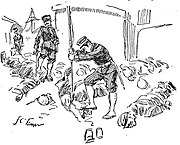
A Western newspaper's depiction of Japanese soldiers mutilating bodies.
The Port Arthur massacre occurred during the First Sino-Japanese War from 21 November 1894 for two or three days, when advanced elements of the First Division of the Japanese Second Army under command of General Yamaji Motoharu (1841–1897) killed somewhere between 1,000 to 20,000 Chinese servicemen and civilians, leaving only 36 to bury bodies,[1] in the Chinese coastal city of Port Arthur (now Lüshunkou). The higher estimates are suspect, however, since a contemporary account of the war estimated Port Arthur's total population at 6,000 (13,000 including garrison troops).[2] Later accounts estimate that 18,000 from each side engaged in the conflict with Chinese dead numbering 1,500.[3]
Background[]
As part of its wartime strategy during the First Sino-Japanese War, Japan had advanced through Korea, engaging Chinese troops at Asan near Seoul and then Pyongyang in September 1894, winning decisive victories on both occasions. Following the victory at Pyongyang the Japanese Second Army under Marshal Oyama Iwao (1842-1916) moved northward towards Manchuria, the plan being to seize Port Arthur, headquarters to China's Beiyang Fleet and a highly fortified city that dominated the sea passage from Korea to northeast China. In September the Japanese navy heavily damaged the Beiyang Fleet at the Battle of the Yalu River, though the Chinese troopships were successful in landing their troops not far from the Sino-Korean border. With the Beiyang Fleet eliminated, the Japanese navy began a siege of Port Arthur while the Japanese Second Army advanced on the city through Manchuria and the Japanese First Army crossed the Yalu River to form another advance by land. After a series of battles on the Liaodong Peninsula the First Division of the Second Army led by General Yamaji drew up around Port Arthur in late November. On November 18, 1894 the Japanese movement down the peninsula was temporarily frustrated and returned to find that their abandoned wounded troops were horribly mutilated with hands and feet cut off.[4] Others had been burned alive.[5] The city was evacuated with residents fleeing westward by land or sea into China. The Chinese had mutilated several Japanese bodies and displayed them at the entrance of the city, infuriating the Japanese. After only token resistance the city fell to Japanese troops late on the morning of November 21. What followed was a massacre of the remaining inhabitants of Port Arthur by the Japanese troops,[6] though the scale and nature of the killing continues to be debated.[7]
Western press coverage[]
The string of Japanese victories at Pyongyang and then at the Battle of the Yalu River had warmed up what had until then been only lukewarm Western interest in the war. By the time of the assault on Port Arthur, a number of western reporters were attached to the Japanese Second Army. Western reporting on the massacre was controversial. Most correspondents such as the American James Creelman, writing for The New York World, and Frederic Villiers, a writer and illustrator for the London Black and White, described a wide scale and cold-blooded massacre. While Amédée Baillot de Guerville alleged in the pages of the New York Herald that no such massacre had occurred,[8] Writing a decade later, de Guerville amended this view, admitting that though some 120 civilians were killed it still had not been a massacre.[9]
See also[]
Notes[]
- ↑ p.330 Villiers, Frederic. The Truth About Port Arthur Cornell University Online Scans
- ↑ Northrop, Henry Davenport. Flowery Kingdom and The Land of Mikado or China, Japan and Corea: Graphic Account of the War between China and Japan-Its Causes, Land and Naval Battles (1894)
- ↑ Everett, Marshall. Exciting Experiences in the Japanese-Russian War. (1904).
- ↑ Everett, Marshall. Exciting Experiences in the Japanese-Russian War. (1904).
- ↑ Northrop, Henry Davenport. Flowery Kingdom and The Land of Mikado or China, Japan and Corea: Graphic Account of the War between China and Japan-Its Causes, Land and Naval Battles (1894)
- ↑ p.209 Barry,R. Port Arthur: A Monster Heroism.
- ↑ see Chapter Seven of Stewart Lone, Japan's First Modern War (London: St. Martin's Press, 1994).
- ↑ New York Times 30 December 1894.
- ↑ Amedee Baillot de Guerville, Au Japon. Paris: Alphonse Lemerre, 1904, pp. 269-280.
Further sources[]
- Allan, James. Under the Dragon Flag. London: William Heinemann, 1898. (This purports to be a true account of the massacre by a young Englishman who had been trapped in the city at the time of its fall.)
- Creelman, James. On the Great Highway, the Wanderings and Adventures of a Special Correspondent. Boston:Lothrop Publishing, 1901.
- De Guerville, A.B. Au Japon. Paris: Alphonse Lemerre, 1904.
- De Guerville, A.B. “In Defense of Japan. The Alleged Atrocities at Port Arthur Denied,” Leslie’s Weekly (3 January 1895).
- Dorwart, Jeffrey M. “James Creelman, the New York World and the Port Arthur Massacre,” Journalism Quarterly, 50 (4) (1973):697-701.
- Hardin, Thomas L. “American Press and Public Opinion in the First Sino-Japanese War,” Journalism Quarterly, 50 (1) (1973):53-59.
- Kane, Daniel C. "Each of Us in His Own Way: Factors Behind Conflicting Accounts of the Massacre at Port Arthur," Journalism History, vol. 31 (1) (Spring 2005):23-33.
- Lone, Stewart. Japan’s First Modern War. New York: St. Martin’s Press, 1994.
- Paine, S.C.M. The Sino-Japanese War of 1894-1895: Perception, Power, and Primacy. Cambridge: Cambridge University Press, 2003.
- Villiers, Frederic, The Truth about Port Arthur The North American Review, vol. 160, no. 460 (March 1895):325-331.
The original article can be found at Port Arthur massacre (China) and the edit history here.